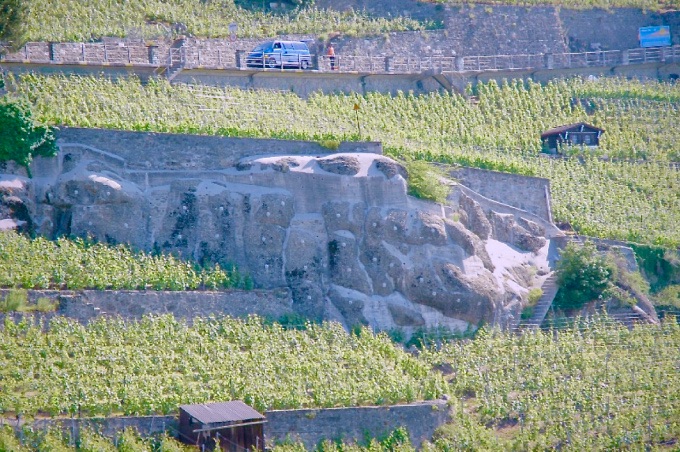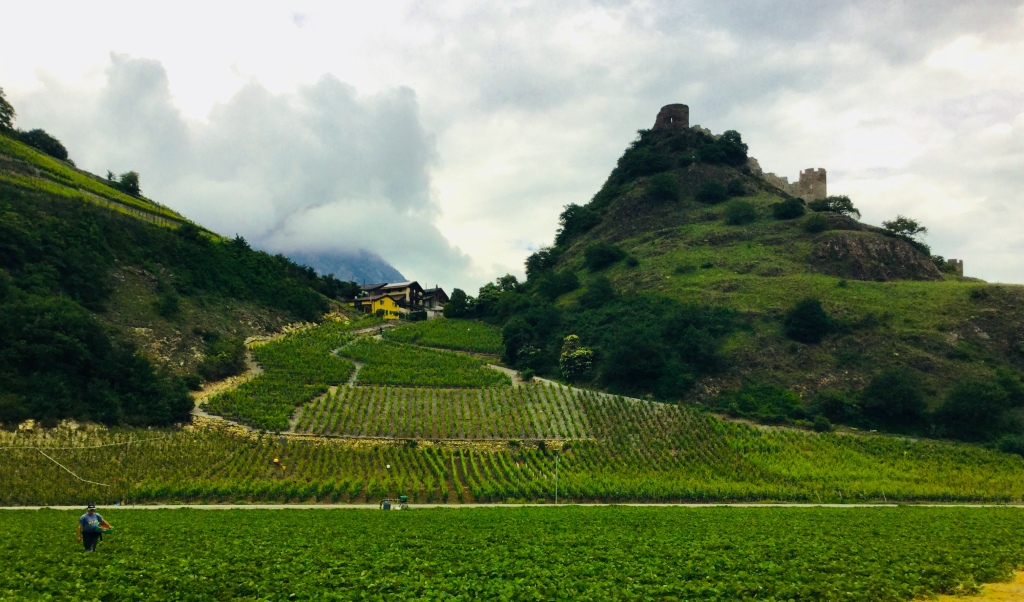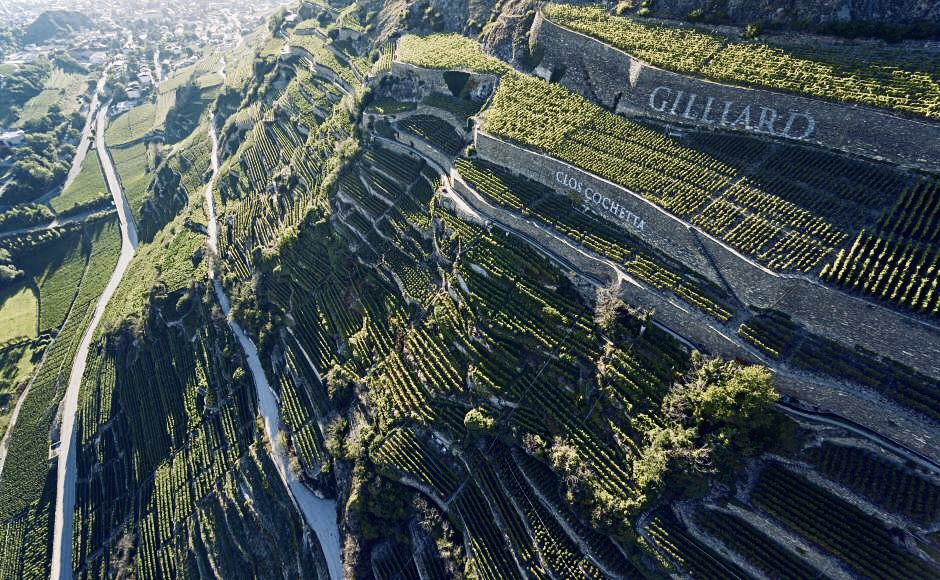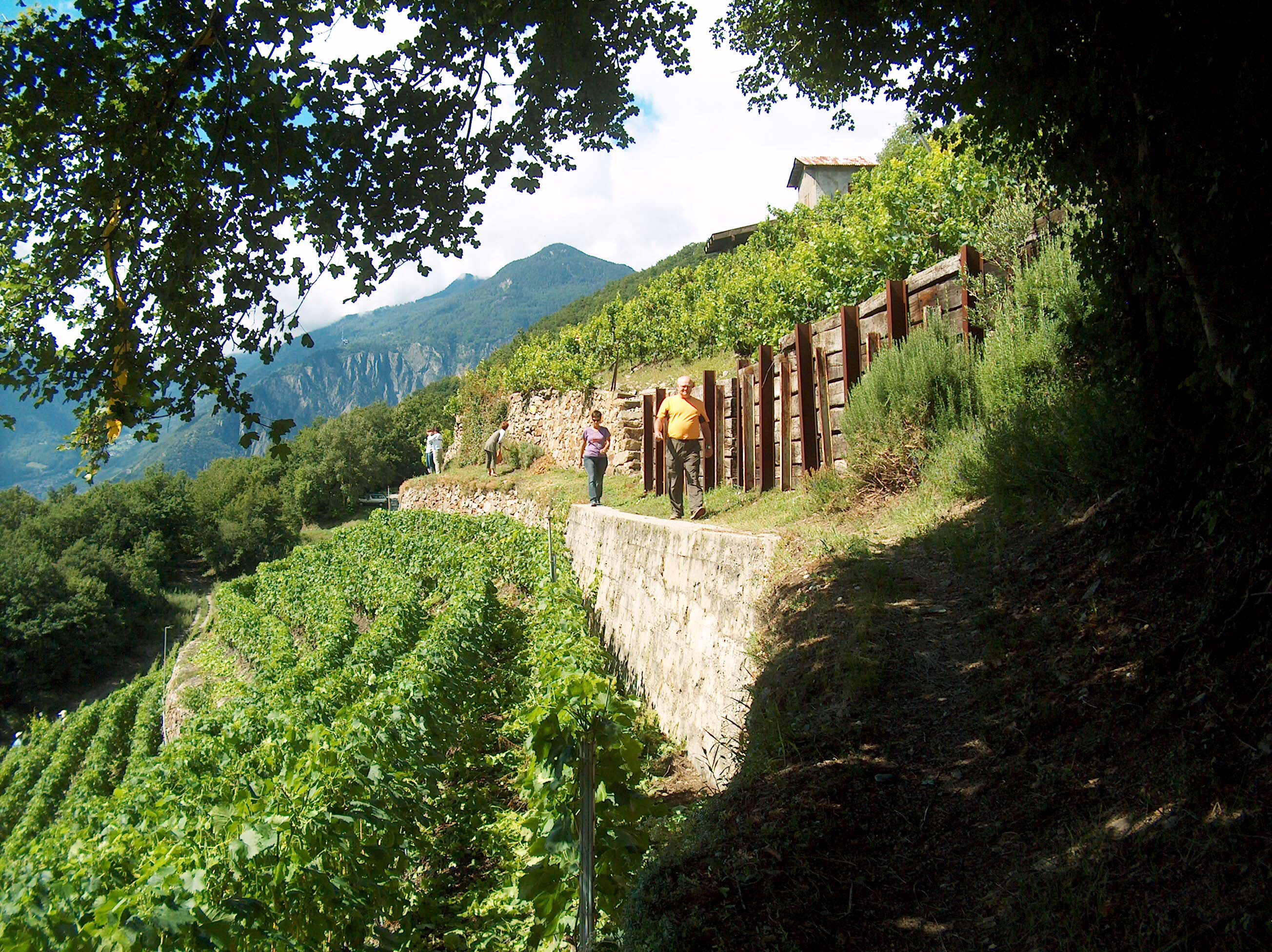I want to talk about walls. Not the politically-charged border walls that divide nations but the visionary walls that make possible seemingly impossible human tasks. The kinds of walls that allow a vigneron to repurpose a steep granite mountainside into a world-class vineyard. I can think of several excellent examples all over Switzerland — some of them of Bronze and Iron Age origin — but none more striking and culturally important than those of Lavaux and Valais.
Of the two regions, Lavaux is the prima donna with UNESCO World Heritage status and a constant flood of tourists. Its vertiginous vineyard terraces are among the most photographed in the world and they are an oft-cited example of heroic viticulture.
But Valais is catching up and its tradition of dry stone wall construction, once in danger of terminal neglect, is now flourishing. Recently, UNESCO recognized the craft of dry stone construction as part of its Intangible Cultural Heritage list. The designation covers ongoing traditions in Italy, Croatia, Cyprus, France, Greece, Slovenia, Spain and Switzerland and it celebrates a diversity of dry stone forms: terrace walls, enclosure walls, barrier walls, outbuildings, and dwellings.
Despite similarities between Lavaux and Valais their traditions have diverged significantly over time. Perhaps because Lavaux’s terraces were built during the 12th and 13th centuries, the capacity and foresight to maintain them according to original specifications was lost. Lavaux’s walls, though beautiful, are a mix of construction techniques including dry stone, cemented and mortared stone, concrete, and other modern processes designed to prevent them from sliding into the lake. (Fig. 1). Still, as a shrine to the native Chasselas grape and to the resourcefulness of generations committed to heroic viticulture, UNESCO rightly celebrates Lavaux’s terraces for their undeniable cultural imprint.
Valais on the other hand has committed to preserve its walls as originally constructed — in a way even Lavaux must envy.

The Original Walls of Valais
Nowhere does the craft of dry stone wall construction fit so perfectly with an obvious need as it does in Valais — one of the most beautiful agricultural landscapes anywhere. As visitors to the region know, much of that beauty is man-made, necessitated by a lack of suitable real estate for farming.
While no one knows the precise date when the first dry stone wall appeared, ecclesiastical records in Saillon mention one in 1341 — around the time Cistercian and Benedictine monks migrated from Lavaux. The first terraces, which may not have been used for vines at all, are believed to have been modest, low-lying, and centered around the castle. (Fig. 2).

Later documents revealed that Italian stone masons were brought to the region in the 18th century to repair existing walls, so there must have been a considerable number built during the intervening 400 years.
As urbanization increased in the 19th century — and agriculture pivoted from polyculture to monoculture — vineyards began to move up the hillsides which led to a boom in dry stone wall construction and a need for laborers. Once again the religious orders stepped up, most likely offering modest wages and penance in return for labor.
One study reveals that between 1880 and 1933 vineyard plantings fell dramatically on the valley floor and increased just as dramatically on the hillsides — particularly between 600-800 meters. The only exception was at Chamoson which saw a dramatic increase in low-lying, non-terraced vineyards at the expense of those higher up.
During this boom it appears the only limitation to the construction of terraces at higher and steeper locations was the availability of water. Hence, the simultaneous development of les bisses, a man-made network of channels to direct snow-melt to the vines from the snow-clad mountains above.
From the low-slung, rudimentary, pre-historic looking walls of Branson to the stately, engineered giants of Clavoz near Sion not one meter of arable land was left unexploited. (Fig. 3)

What’s Up Above Is What’s Below
The value of Valais’ walls is more than just economic and cultural. They are critical in preventing landslides, erosion and desertification. They are habitat friendly to insects, birds and small animals, and they play an influential role in the slightly murky topic of terroir. Heat is stored in the walls by day and is released by night. Some claim it assists in fruit maturation.
The walls also tell the story of the region’s geology with each area displaying the predominant stone of the region. One set of walls at Clavoz with its iconic Clos Cochetta is a great example. It is built with stones from on-site and from several nearby quarries, each with its own imprint. A study done by the École Polytechnique Fédérale de Lausanne (EPFL) contains the following description:
The materials taken from (Cochetta) consist mainly of schists, limestones and some granites. For building stones or more massive foundations, other sites have been identified following an appraisal. The light beige stones come from the old Bramois quarry, the blue – greenish stones were extracted from the old St-Léonard quarry while the whitest stones would come from the Prabé massif.
At Fully’s famous Combe d’Enfer (Fig. 4) one finds gneiss and schist among the dry stone materials that make up this magnificent amphitheater of vines. Many of the walls were rebuilt as little as twenty years ago, although wine has been made here for centuries.

A New Era of Wall Consciousness
With the liberalization of wine imports in the late 20th century, the Swiss wine industry was put on notice that indifferently made wine was no longer an option. In order to survive, the entire industry was obliged to improve the quality of its output. This national push required significant investment and for those growers on the steepest slopes the cost of regular wall maintenance proved a disadvantage. As a result, shoddy repairs began to scar the landscape, threatening to undo centuries of exquisite craftsmanship. (Fig. 5).

In 2001 the canton of Valais commissioned a study and approved a plan of action for the restoration and maintenance of its dry stone walls. An inventory of the canton’s 3000 kilometer network was undertaken and each section was graded according to its structural integrity. Approximately 30% was judged in need of repair.
In a nod to the burden of heroic viticulture and in the spirit of shared responsibility, the study recommended public financing for the maintenance of the canton’s walls.
Cost estimates for repair and maintenance are fixed: CHF 600 per square meter for walls less than 1.5 meters in height; CHF 900 per square meter for walls greater than 1.5 meters in height. Individual owners can access federal, cantonal, communal and municipal funds before spending out-of-pocket. In addition, vineyards located on terraces are eligible to receive direct payments from the Federal Office of Agriculture (OFAG) of CHF 5000 per hectare when planted on slopes of more than 30%.
The total investment contemplated by the study: CHF 200 million.
The study’s findings came at a critical time in the canton’s evolution as a world-class wine region — just ten years removed from its inception as an AOC. The region was in danger of losing one of its most visible cultural assets and a critical component of its agricultural infrastructure.
The shared commitment to revitalization has proven wise.
Twenty years into the investment and Valais is emerging as one of the leading wine regions of Europe. Nowhere is there such a diversity of wine made from native and classic varieties, all of which flourish in the unique landscape of its terraced vineyards.
With the increased value of the wine produced, an influx of high-spending tourists both in winter and summer, and significant business investment within the canton, Valais is poised to become not only one of Switzerland’s most dramatic landscapes but one of its most culturally and politically savvy.
Discover more from artisanswiss
Subscribe to get the latest posts to your email.
Stunning piece! Outstandingly informative and eye-opening.
LikeLike
Thanks so much, Valerie.
LikeLike
A fine article on a wonderful subject! A note for anyone interested in the walls in Valais: “Murs de Pierres, Murs de Vignes”, published by the Valais Wine Museum in 2012, is an authoritative and beautifully illustrated book (in French) based on considerable scientific research that otherwise appears only in scholarly documents. There’s a lengthy part at the start about the difficulties of determining when the first walls appeared, but they are ancient, and the first recorded mention of walls is from 1189-1203 (the record isn’t precise), the Clos de Bouson in Sion. So a bit earlier than what you mention here. Hats off to Valais for its determination to maintain these walls, a significant financial investment and a massive amount of never-ending work for the growers, who nevertheless are proud of these walls, rightly so.
LikeLike
Great info. Thank you Ellen, I will check this book out. So there is evidence the first walls in Valais are contemporaneous with those in Lavaux? I had read that it was the migration of monks in the 14th century that kickstarted wall building in Valais. So this is great info I hadn’t seen before. Love it.
LikeLike